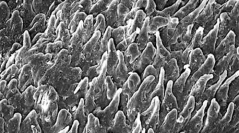

 Comptes Rendus Palevol
4 (1-2) - Pages 67-77
Comptes Rendus Palevol
4 (1-2) - Pages 67-77Plant cuticles have proved to be a high-resolution proxy of palaeo- pCO2 variation. Mesozoic gymnosperms, however, show a wider range of xeromorphic adaptations than their living relatives, and these may explain stomatal density/stomatal index differences between taxa within the same fossil assemblage. Four main adaptive responses to water loss are pointed out: reduction of solar radiation, reduction of drought-air circulation, reduction of evapotranspiration, and trapping of surface external water. In conclusion, we recommend supplementing quantitative estimates of stomatal density and index by qualitative observations of cuticular adaptive macro- and microstructures.
Cuticles, Gymnosperms, Mesozoic, adaptations, palaeoclimatology